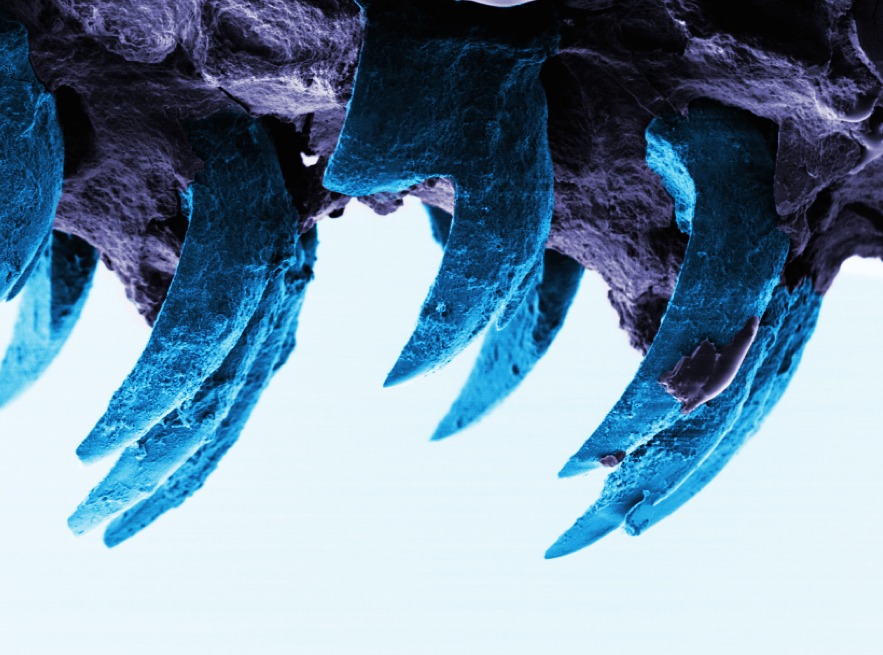Sorry to disappoint, but the answer is no! This worm only eats carbonate limestone, a very soft rock. It wouldn't have any impact on the priestly gemstones.
 There was actually a much more interesting discovery a few years ago, when scientists discovered
the strongest biological substance known to date. It's the teeth of a
tiny creature in the snail family - the limpet, a small conical creature
which is a familiar sight on rocks at the seashore. That's a much better candidate.
There was actually a much more interesting discovery a few years ago, when scientists discovered
the strongest biological substance known to date. It's the teeth of a
tiny creature in the snail family - the limpet, a small conical creature
which is a familiar sight on rocks at the seashore. That's a much better candidate.In truth, the Gemara does not state that the shamir was an animal - it just describes it as something the size of a barley kernel, which had to be kept in a lead tube. In my book Sacred Monsters, I discussed Immanuel Velikovsky's original idea that this refers to a radioactive substance. Rambam and Rashi, however, describe it as a worm-like creature. Rabbi Dr. Moshe Tendler suggests that it is a snail from the genus Euchondrus, which carve gouges in rocks in the Negev desert. However, as I noted in my book, these limestone rocks are much softer than the gems of the breastplate. But, I noted, there are marine mollusks with much stronger dental equipment, and therefore it is therefore not beyond the realms of biological possibility to posit that there is (or was) a species of invertebrate that could indeed engrave the gemstones of the priestly breastplate. The limpet might be such a candidate, although it is difficult to see how it could have actually been employed in this way.
A second way in which this discovery relates to Judaism is in the symbolism of it. The Gemara says as follows:
"The Rabbis taught: There are five fears with which the fear of the weak is upon the mighty: The fear of the leontophone upon the lion, the fear of the mosquito upon the elephant, the fear of the gecko upon the scorpion, the fear of the swallow upon the vulture, and the fear of the kilbit-fish upon the whale. R. Yehuda said: What is the scriptural source? “He grants the robbed one power over the mighty” (Amos 5:9). (Shabbat 77b) (See the Torah Encyclopedia of the Animal Kingdom for discussion of this passage.)The idea here is that the very smallest creatures in the world are often the strongest in some way. This reminds us not to attribute too much power to the physically intimidating. The very strongest biological substance of all is not the fangs of a lion or the tusks of an elephant - it's the teeth of a humble snail.


It also says in סוטה, since the churban, בטיל שמיר
ReplyDeleteNice piece!
ReplyDelete"Rabbi Dr. Moshe Tendler suggests that it is a snail from the genus Euchondrus, which carve gouges in rocks in the Negev desert. However, as I noted in my book, these limestone rocks are much softer than the gems of the breastplate."
ReplyDeleteYes, but could that be what they were imagining even if it really wouldn't work?
The animal that kills the most humans by far is the mosquito.
ReplyDeleteA bit off topic, but did you ever post about the medrash of enormous grapes the spies carried 8 to a bunch. ?
ReplyDeleteIf so, please could you link.
That the Shamir does not HAVE to be a worm was made by L. Ginzberg in Legends, who notes that the Midrashim themselves do not say explicitly whether the Shamir was a mineral, plant or animal. Tho most of the Rishonim understand it to be some sort of worm. The Abarbanel in Kings says the blood of the Shamir was used to mark cutting locations, and by following that trail the artisans were able to create perfect work.
ReplyDeletewho needs a shamir?! Today we have lazers which can do the job. Cut by the light! What can be more mehadrin min hamehadrin!
ReplyDelete